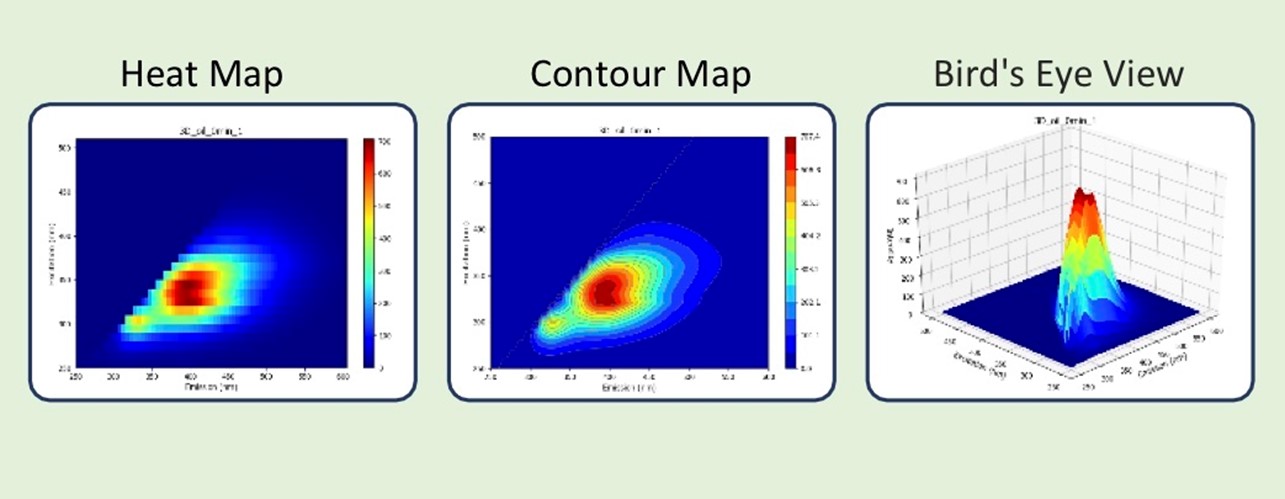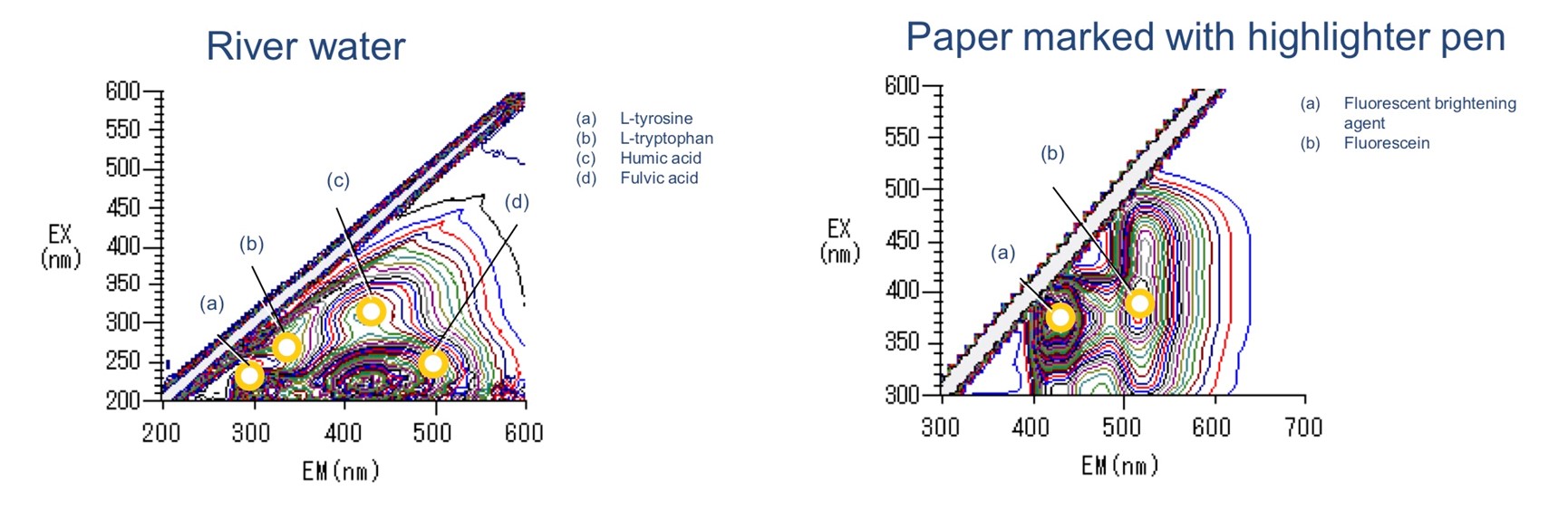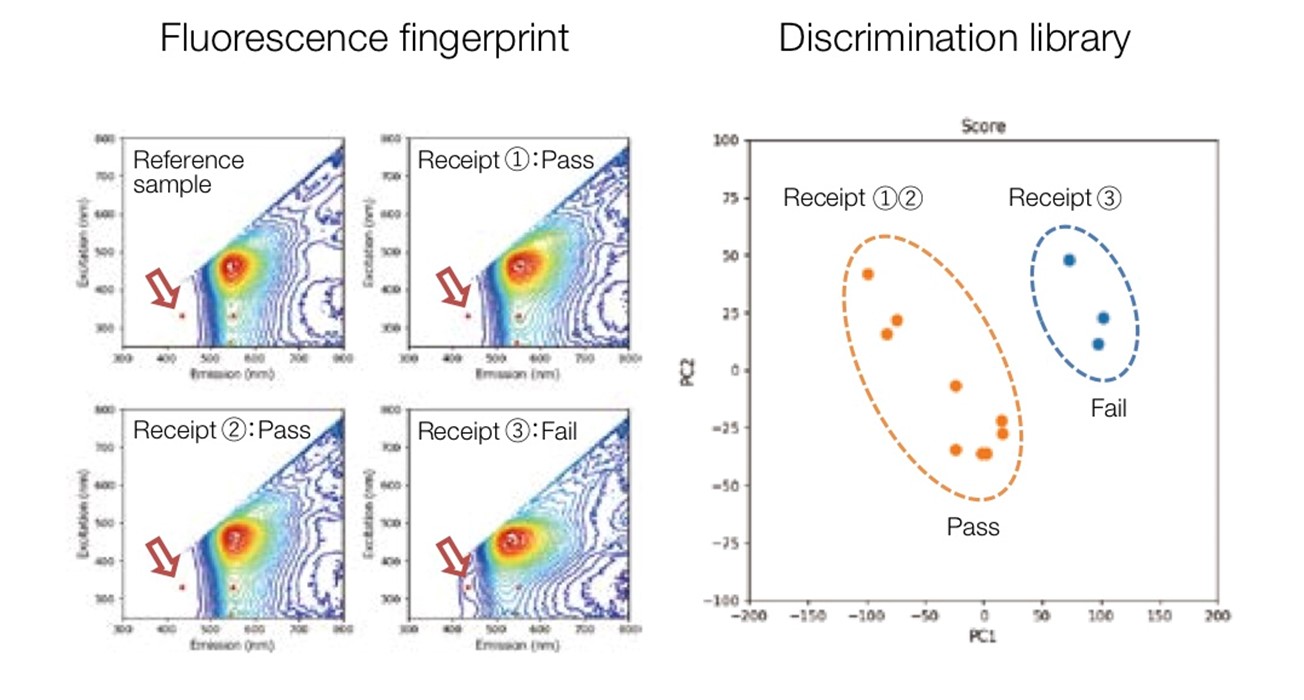
Fluorescence fingerprinting using the Excitation Emission Matrix (EEM)
Fluorescence fingerprinting using the Excitation Emission Matrix (EEM) method is a powerful and wide ranging technique in fluorescence spectrophotometry. The intensity of the fluorescent light emitted in fluorescence spectrophotometry is dependent on both the excitation and emission wavelengths. A fluorescence fingerprint is obtained by plotting these 3 parameters in three dimensions as a 'bird's eye' view or contour map.

The contour lines represent regions of the same fluorescence intensity. Each fluorescent material has a characteristic contour pattern, or 'fingerprint' which can be used for identification purposes:

Multivariate software for 3D scan analysis can be used to estimate the relative amount of fluorescent substances present in specimens, light absorption characteristics, and fluorescence wavelength characteristics. Fluorescence fingerprints from known samples can be collected and processed to create 'identification models' of much fewer variables which are held in a reference (discrimination) library. Fluorescence fingerprints of unknown samples are then acquired in the same way and compared to the references to enable a wide range of analyses to be made. To make the process easy fluorescence fingerprinting systems complete with a rapid scanning fluorescence spectrophotometer and analysis software are available, such as the Hitachi F7100 Fluorescence Fingerprint Measurement and Discrimination system
Fluorescence fingerprinting in action
The multivariate software can process fluorescence fingerprint data to extract and classify information such as composition, concentration and environmental load. This can be used for checking purity, abnormalities in raw materials, mixture compositions, freshness due to organic degradation and more.

In this example, the fingerprints from a number of lots of raw turmeric were compared to the reference sample in the discrimination library. The detection of anomalous peaks in sample 3 enabled it to be flagged as a 'fail'. Analysis is possible on liquid or solid samples and the technique can be used in a host of industries:
- Food (fruit, vegetables, cereals, meat, fish, edible oils, beverages, etc)
- Pharmaceutical (crude drug identity, microorganisms etc)
- Industrial (resins, adhesives, mineral oils, paint, dyes, detergents etc)
- Printing (paper, inks etc)
- Environmental (river water, lake water, sea water, soil, plants etc)
Since fluorescence fingerprint analysis measures the fluorescence possessed by the sample itself, there is little need for sample preprocessing such as grinding, dissolving, or filtration. Samples such as fruit fragments or raw meat can be analysed directly, meaning that even an inexperienced analyst can use the system.
Applications include:
- Checking the degradation state of raw materials and controlling expiry dates
- Detecting abnormal raw materials
- Inspecting shipment products (identity confirmation)
- Classification according to composition
- Simple pass-fail quality control
- Identifying mislabeled products
High speed data acquisition and processing
3D EMM scans generate tens of thousands of data points for analysis and the F7100-based system provides fast and accurate data acquisition thanks to one of the fastest scan speeds in its class (60,000 nm per minute). It also features automatic setting of response processes for high-speed scanning, rapid excitation wavelength switching and a filter accessory which automatically removes the effects of higher-order light which could affect measurement accuracy. Data is transferred directly to the 3D SpectAlyze statistical multivariate analysis software which can automatically select the optimal wavelength for differentiating sample components, calculate the formulas for the discrimination library, resolve peaks from multiple components, and much more.
Versatile sample handling
In addition to the basic system, it is possible to add a 98 well microplate accessory and a powder sample guide for continuous measurement of liquid or powder samples. For large, irregular shaped samples, an optical fibre accessory allows direct measurements to be made.
Fluorescence fingerprint systems from Lambda Advanced Technology
Lambda Advanced Technology is a leading supplier of analytical instruments for a wide range of applications, including the Hitachi F7100 Fluorescence Fingerprint Measurement and Discrimination system. If you would like more information, simply contact a member of the team today.